|
|
| Wang
Jianwei's Symptom at Nyon
Zhang Ga explains that Symptom “offers a formal language on the surface. But, underneath, there are costumes, dramas, historical references and a unique vocabulary.” A symptom is what a patient feels when something goes wrong in his or her body or mind. It is what the patient tells the doctor. But the degree of information provided by the patient reveals his or her background and understanding of the chronological order of the development of the symptom. On the other hand, the reading given by the doctor comes from his or her scientific approach and experience. So, what is the exact relationship between a patient and a doctor? And what can solve the problem? What is the part of science, art and philosophy when it comes to sensing the vulnerability and the instability of a society? The patient is a metaphor for the society composed of individuals taken despite them in the farce that is History with a capital H.
Born
in 1958, Wang Jianwei started his career in the late 1970s
as a painter. From the beginning his work was engaged
with social interactions. New media, introduced in China
in the early 1990s,
gave him a flexible format that was just beginning to
be elaborated even in the West. New media gave him a vehicle
to think about
and to express the new paths that his country was suddenly
being allowed to take. A broad new avenue for history was
traced by
the officials. But for a population still stigmatized,
it was an avenue leading to the unknown. Artists like Wang
Jianwei
took small alleys emerging from the avenue swelled with
official messages promising an economic future, but giving
no key to create
new models for expression.
The
videos are treated as mini-historical frescoes in which ancient
China, the overthrow of the Imperial
China, the
early Republic,
the creation of the People’s Republic of China
in 1949, the open door policy in 1978, and the integration
of the country
into the global economy are compressed and mixed along
a single time line narrative. The artist, Wang Jianwei,
confronts us
with history in its purest stereotypical perception.
How does the West know China? Where are the nuances
between our romantic
vision of the past and our fears about a new imperialism?
Stereotypes activate our behaviors. Here they explore
how our knowledge is
constructed when historical, social and cultural elements
are interacting. Wang Jianwei says, “Stereotypes
work on the visible and the invisible; on the relations
between East and
West.” For this reason, characters that he stages
in his videos and photographs come from different times
and
social levels
although they are all Chinese. The superimposition
of historical contexts, social amalgam and individual
paths
make them
strangely identical and out of phase. This feeling
is enhanced by the
fact that the photographs look like prints taken from
the videos.
In fact, they are carefully, methodically constructed
as momentum of time. The effect is three-dimensional.
Incorporating
a banal object such as the armoire is enigmatic or even disturbing.
But is this not
a strong
relationship
to the characters staged in the videos and photographs?
They are
costumed and they act as individual anomalies though
they follow the artist’s scenario. The sounds and
the motion of the armoire strangely echo the methodical
behavior of the characters.
I asked Wang Jianwei how he conceived the relationship
between the armoire, the film, the videos and the photographs. “The
relationship is with the title of the exhibition,” he
told me. “Videos are directly taken from
performances. Photos are not taken from the videos.
This is another
work. We are
thus in the same situation but we do not find the
exact copy. The
armoire is to be understood in that sense when
things belong to the same situation but are also
independent
while being
linked. In Beijing, I did a sculpture from a photo
of the first bomb
that was built in China. I wanted to represent
the bomb the way it was. The bomb never exploded
in reality
but
it became
a very
strong political symbol. The symbol becomes a brand.
It is irrelevant whether the bomb explodes or not.
It is the
symbolism
that counts.
It is the same here with the armoire. We link here
with the title of the exhibition, Symptom. It is
like somebody
who
is sick and
goes to the doctor. This is not a simple question.
It is not a question of going to the doctor and
mentioning bodily
changes.
It is like a detonator. A detonator that indicates
a
change. It is the same in politics.”
|
All material copyright 2010 by 3 dots water

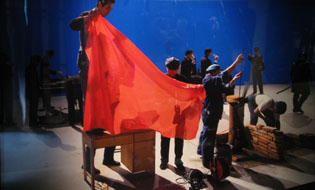
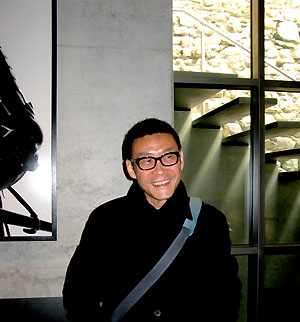
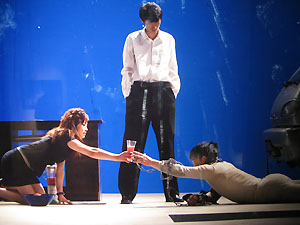
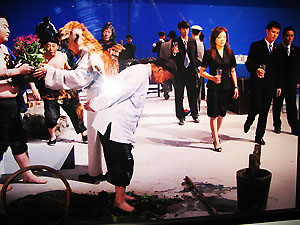
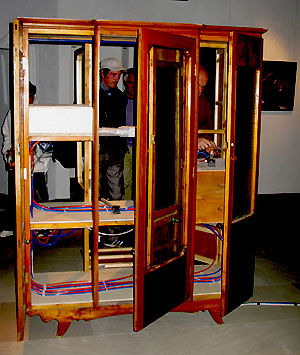
 Zhang Ga, Curator of Symptom,
Zhang Ga, Curator of Symptom,  Vincent
Lieber, Conservateur du Château de Nyon,
Vincent
Lieber, Conservateur du Château de Nyon,